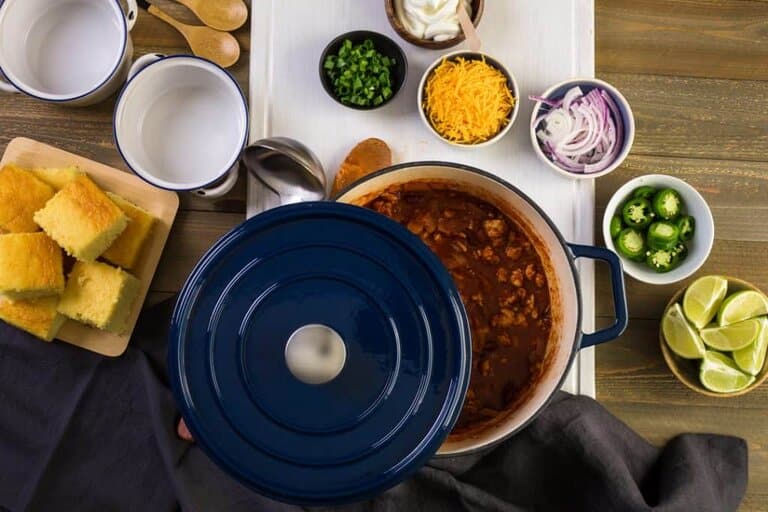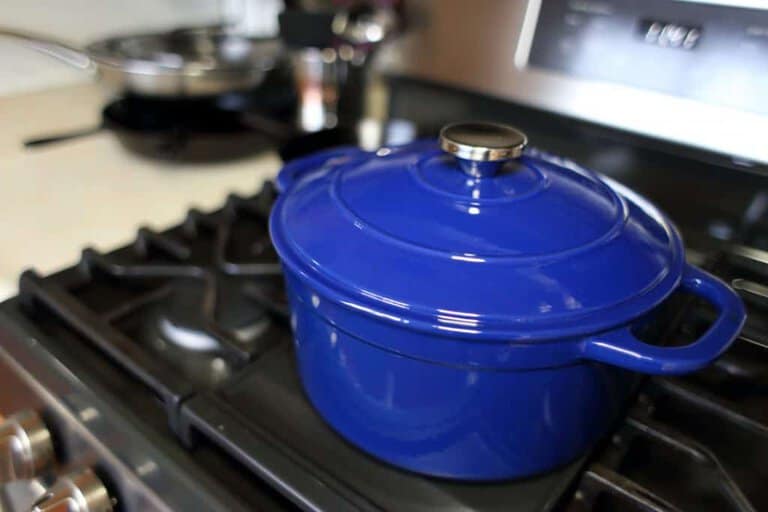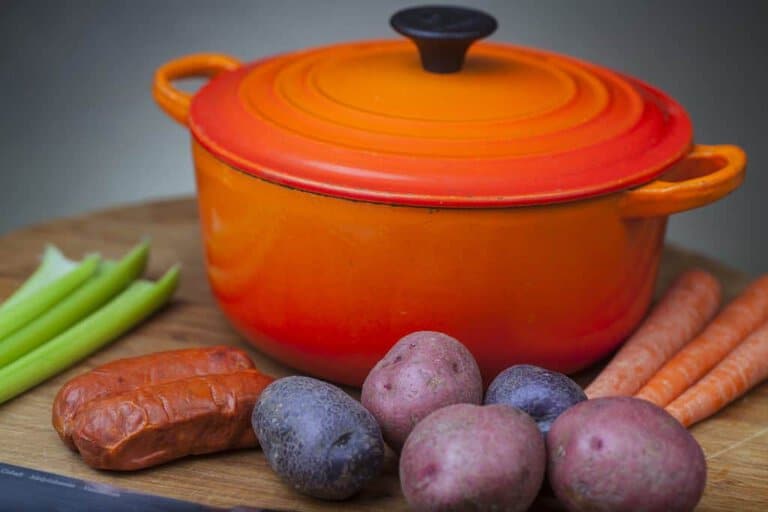To safely use a dutch oven on an electric stovetop, first wash it in soapy water, then carefully place it on the stove to avoid scratching it. Next, add oil to the dutch oven to prevent sticking and burning, and heat slowly to allow food to cook evenly.
Dutch ovens are one of the best investments I have ever made in my kitchen. They are my favorite way of creating different types of dishes while saving a ton of money on gas and electricity. You’re missing out on an essential kitchen appliance if you don’t have one!
However, if you’re new to using the dutch oven, It could be a challenge to understand how to make the most of this iconic and versatile kitchenware.
Perhaps you are not entirely sure if you can use your dutch oven on an electric stove. Or maybe you’ve tried it before but didn’t get great results. This guide will show you exactly what you need to know about using a dutch oven on an electric stove.

Can You Use a Dutch Oven on an Electric Stove?
This is a question I get asked a lot. Electric stoves are rapidly replacing traditional stovetops in many American homes. So everyone wants to know if it is safe to use their old dutch oven on an electric or glass stovetop.
The answer is, Yes! Dutch ovens are made to be highly heat-conductive, making them ideal for use on electric stovetops and on gas and induction stoves and ovens.
However, below are a few conditions you’ll need to consider before placing your Dutch oven on your electric coil.
- Only cast iron dutch ovens with enamel coating can be used on an electric stovetop, not ceramic or stoneware dutch ovens.
- A ceramic dutch oven is considered a ‘Bakeware’ that should only be used in a conventional oven and should not be placed on any type of stovetop because it will crack if the heat source hits it in one spot.
- As a rule of thumb, always use a lower heat setting on your electric stovetop when cooking with a dutch oven.
Now that you are sure you can use your dutch oven on an electric stove. Let’s look at the best practices for making your favorite dishes with your oven.
How To Use A Dutch Oven On An Electric Stove

Dutch ovens are very simple to use on any heat source. They are used in the same way as any other pots, except they need a different temperature setting.
To properly use your dutch oven on an electric stove, follow these simple steps:
Wash Dutch Oven Before Use
Before using your Dutch oven, ensure it is clean inside-out and free of any food residue from previous use.
Start your cleaning by;
- Washing the dutch oven in hot soapy water.
- Then, dry the cookware with a soft cloth.
Place Oven Gently on Electric Stovetop
Despite being an expensive piece of cookware, dutch ovens need to be handled with care. You can’t afford to drop or drag your dutch oven across the countertop or scratch it with a metal cooking utensil to avoid damaging its enamel.
To keep your dutch oven safe;
- Place the dutch oven gently on the stovetop when setting it down.
- Always lift the dutch oven rather than drag it when the cooking is finished.
Coat Pot With Oil
Putting dry food into a dutch oven can cause it to stick and burn. So you should always coat the surface of your dutch oven with oil or butter before adding food.
Set The Temperature
Dutch ovens work best when they heat up slowly and remain warm. Overheating can cause the contents of the pot to stick or even burn unevenly.
To be on the safe side;
- Set the burner to a safe medium or medium-low temperature.
- Do not preheat an empty dutch oven before putting food in it.
Add Your Food
A Dutch oven can be used to prepare a wide range of meals, including searing meat, roasting, frying chicken, boiling stews, and steaming pasta. The list is endless.
Here are some cooking tips;
- Prepare all of the ingredients; peel, chop and dice them down.
- Some recipes call for cooking food uncovered; keep lids open when making foods like pasta.
- Place a lid on the top of the oven when braising meat in a dutch oven to trap steam.
- Slowly heat the oven to allow food to cook evenly.
- Gently remove the oven from the heat and serve your delectable meal when the cooking is finished.
- If you want to keep the food warm for a second serving, simply keep the lid seal on.
Wash Dutch Oven After Use
When heated, oil and other residues can stick to the bottom of your dutch oven, leaving a black mark on it.
To avoid burnt food or stains on your dutch oven;
- Remove the dutch oven from the stovetop immediately after use.
- Allow the oven to cool completely before washing. Do not submerge a hot dutch oven in cold water, as this can cause thermal shock and damage the pot.
- Clean both the interior and exterior of the pot with dish soap, warm water, and a soft scrub pad.
- To remove burnt and stubborn food stains, wash the pot with warm water and baking soda.
- Rinse off the cleaning solution with cold water.
- Finally, allow the dutch oven to completely dry before storing it to prevent iron rust.
Clean Electric Stove
Whether your electric stovetop is coiled or flat, it can retain food residue when heated. Cleaning your stove top before and after each use helps prevent rust and extends the life of your appliance.
To start your cleaning;
- Switch off your stove and unplug it from the wall.
- Remove any leftover food, dust, or other debris from the stove.
- Using a paper towel, remove anything stuck to the surface.
- Then, add baking soda paste to the stovetop to soften hard stains.
- Wait a few minutes for the baking soda paste to sit on the stovetop.
- Now, scrub the stove with a sponge to remove hard stains.
- Then finally, wipe down the cleaning solution with a damp cloth or towel.
What Can You Cook in a Dutch Oven?
You can cook all kinds of food in a dutch oven. It’s arguably the most versatile cookware. However, here are some of the most common uses of a dutch oven:

Searing: Cast iron dutch ovens are ideal for searing meat. They can withstand high temperatures, which are required to brown your meat. And when the stock and other ingredients are added, the oven gently braises to prepare your restaurant-quality meat steak.
Soups and Stews: A dutch oven is also perfect for making soups, stews, and braises. These recipes often require long cooking times and low temperatures to allow the flavors of the various ingredients to meld and allow tough cuts of meat to get soft.
Frying: Try making french fries in your dutch oven and thank me later. Deep frying requires a large amount of oil and a significantly high temperature. So the thermal properties of an iron cast dutch oven make it perfect for all types of frying.
Roasting: You should also experiment with roasting in your dutch oven. The result is savory. When you roast meat in a dutch oven, the heat is distributed evenly throughout the pan, allowing for even cooking. The lid also perfectly seals the oven and traps steam, keeping your meat moist.
Other Uses: You can also use your dutch oven to boil water, steam pasta, bake beans, cook vegetables, and, of course, bake cakes and bread (although not on a stovetop but in a conventional oven).
So how do you maintain such versatile kitchen equipment?
Dutch Oven Maintenance Tips
- Read and follow the manufacturer’s instructions before putting your new dutch oven on the stovetop. I do this for all my kitchen appliances, and I think you should too.
- Check to see what material your dutch oven is made of before placing it in an electric stove. As I mentioned earlier, only cast iron-based dutch ovens, not ceramic or stoneware.
- Watch out for scratches, cracks, chips, warping, and unsealed lids.
- When cooking, watch out for temperature changes; clean the device thoroughly to remove burnt food and stains, and dry the oven thoroughly before storing to prevent iron rust.
FAQs On Dutch Oven On Electric Stove
What Can I Do With a Dutch Oven?
Dutch ovens can be used for roasting, baking, frying, cooking, and preparing hot beverages. They can also be used to keep food warm or cold, chill drinks, and prepare and serve desserts.
Can I Cook with a Dutch Oven on a Glass Stove?
Yes, you can cook with a dutch oven on a glass stovetop. However, you must handle it with care and attention. Dragging a Dutch oven across the surface of a glass stovetop can easily scratch or damage the glass, especially if the oven is filled with food.
